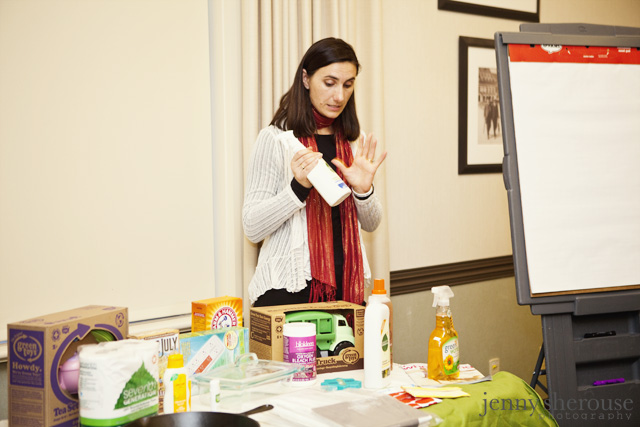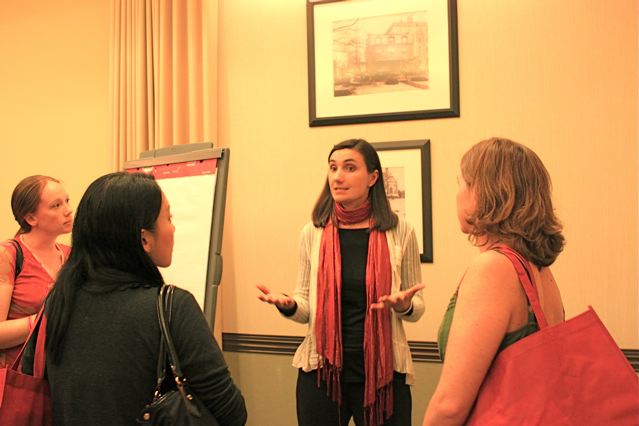By Jen Rabulan-Bertram, The Next Kid Thing
With so many environmental factors attributing to health issues and concerns, for many families, green living is more relevant now, more than ever. At this year’s Mommybites’ Summit, green experts and advocates, Susan Hunt Stevens and Sarah Finnie Robinson, led a discussion dubbed “Live Practically Green: How to make smart, healthy green choices for your family and home.”
Susan Hunt Stevens, founder of Practically Green, an online resource that helps families make practical, eco-friendly decisions, began her green home-life makeover after her young son was diagnosed with serious food and environmental allergies. In the discussion that overviewed tips for making greener decisions, Hunt Stevens also recommended products and resources to help navigate the often-confusing green marketplace.
Hunt Stevens began the discussion on green living by sharing some of the realities that many families face today:
- According to research, the cost of children’s healthcare due to environmental issues is more than $78 billion dollars a year
- This also translates into lost days from work, sleepless nights, visits to the doctor.
- 30% of parents of children under the age of 10 face one of the Four A’s: ADHD, Autism, Allergies or Asthma
- Some of these health issues can be hereditary; however, 80% is said to be caused by other factors.
There are ways to minimize these health issues, but not eliminate them, Hunt Stevens says. Families can make simple changes in their everyday routine to make their homes greener and healthier.
Cleaning Products
Opt for greener cleaners that use safer ingredients, instead of harmful chemicals. What defines a green product? There’s no true definition of a green product, but products that are considered green usually do not harm human health (e.g. carcinogenic, endocrine-disruptors) and environmental health. Because there are products on the market that may “greenwash,” Hunt Stevens suggests to refer to reputable resources like the Good Guide when searching for a true green cleaner. The Good Guide offers scores on products based on environmental and social impact. Seventh Generation offers a great range of household green products, that Hunt Stevens says tends to be higher-minded in terms of social and environmental impact, which may reflect in the pricetag. Green Works from Clorox is an affordable green cleaner that is also certified per the Natural Products Association.
Natural remedies are also alternatives to conventional products. For cleaning, baking soda is a versatile, inexpensive option that can already be found in most homes. Whether you’re a city-dweller or suburbanite, Hunt Stevens says it’s important to avoid pesticides in and around your home. For instance, to combat pesky ant invasion, basil and cayenne can sometimes work more effectively than store-bought pesticides. When considering cleaners like dishwasher detergents, it’s important to consider the environmental impact as well. Watch labels for environmentally-unsafe phosphates, and opt for cleaners such as Biokleen that steer clear of chemicals that are harmful to the environment.
Skincare products
The number one concern with skincare products are parabens. Parabens are described as chemicals that serve as preservatives, but also mimic the hormone estrogen. Phthalates are another factor to consider when choosing healthier cosmetic or skincare products for the family. Phthalates are often listed as synthetic fragrances on labels. Babies are susceptible to phthalates because it concentrates in their bodies. A resource to consider when choosing safer skincare products is the Environmental Working Group’s Cosmetic Database which can be found at skindeep.org. EWG rates health and beauty products from 1-10, based on their effect on human and environmental health. Always a must-have in the beach bag, safe sunscreens that are greener, safer alternatives include Badger and California Baby.
Kitchen
In the kitchen, Hunt Stevens suggested that there are a variety of ways to be greener, but in general, going back to basics seemed to the most important message. Because of the chemicals that are released when heated, plastics should be avoided in the kitchen. Instead, opt for more sustainable options such as glass and stainless steel. For storage and warming food, glass products from Snapware and Pyrex are safer alternatives to questionable plastics and melamine. With the health implications related to Teflon, Hunt Stevens said that cast iron skillets are the way to go. The care and upkeep of a cast iron skillet outweighs the uncertainty of other sorts of pans.
Other Green Products
Hunt Stevens offered a number of other green products that parents should consider
- Mattress: Naturepedic offers organic crib and toddler bed mattresses. If this isn’t an option, air out a conventional mattress for a few days
- Toys: Toymakers such as Green Toys and Sprig offer more sustainable play options.
- Food: For produce, if you choose to buy conventional, avoid the “dirty dozen” and opt for the “clean fifteen.” Consider joining a CSA, shop at farmers’ markets and eat less meat by going vegetarian a few days a week.
- Reusable sandwich and snack bags: Instead of throw-away baggies, try reusable sandwich and snack bags from companies like Snack Taxi.
Photo 1 was taken by Jenny Sherouse. Photos #2 & 3 were taken by Jen, the author.
__________________________________
A former mag. editor turned freelance writer & blogger, Jen is a green-living, pop culture-loving mom that loves the good things in life. Loves tech & too much tv. http://nextkidthing.com






